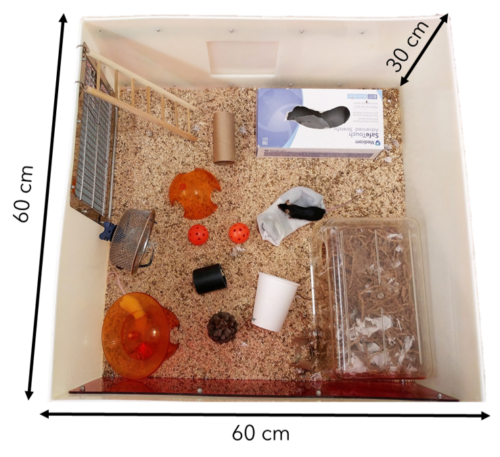
A first-ever study by University of Guelph researchers shows that standard “shoebox” lab cages are so stressful for rats and mice used in biomedical research that they impair the animals’ health.
Besides raising animal welfare concerns, the finding published recently in the journal BMC Biology suggests that improving cage design could help solve a serious practical problem: currently, most drugs developed using animals fail to work well on humans.
In the new study, an exhaustive meta-analysis of research literature by the U of G investigators found conventional laboratory housing shortens rodents’ lifespans and increases the severity of a range of stress-sensitive diseases from cancer to depression.
This research was recently featured in The Globe and Mail.
“We’ve known for years that rats and mice prefer to live in large ‘enriched’ cages offering warm nests and full of activities to do,” said Dr. Georgia Mason, a professor in the College of Biological Science and director of U of G’s Campbell Centre for the Study of Animal Welfare. “But nobody had asked whether confining them in small, unstimulating cages causes the same health problems seen in stressed people.”
More than 120 million mice and rats are used every year in biomedical research around the world, often for developing new therapies for human health. But up to 90 per cent of new drugs that work on these animals subsequently fail in human clinical trials.

The rodents’ housing varies from small bare-bones cages – the norm – to well-resourced (“enriched”) quarters with adequate nesting materials for warmth and with enough space and items to promote exercise and exploration.
From an initial collection of about 10,000 studies worldwide involving rodent research, the research team ultimately analyzed about 200 papers to explore links between housing quality and health.
Those papers contained data from nearly 6,500 animals, mostly males. All used study designs that included both conventional and well-resourced cages, and that collected data on mortality or stress-sensitive diseases induced in the animals. These disease data came from mice and rats induced to develop cancer, stroke, cardiovascular disease (CVD), anxiety or depression.
Cramped housing leads to poorer lab rodent health
In all cases, conventional cages were associated with poorer health outcomes. In cancer studies, rodents in conventional housing developed larger tumours on average than those in enriched quarters. Similarly, in CVD studies, conventionally housed animals developed larger arterial plaques. This pattern repeated across all diseases investigated. Just under one-third of the animals were female.
For bare-bones accommodation, researchers have even come up with an acronym for their occupants: CRAMPED (cold, rotund, abnormal, male-biased, poorly surviving, enclosed and distressed).

“We found that the cages normally used in labs shorten animals’ lives and consistently made these diseases worse,” said Jessica Cait, a PhD student in Mason’s lab and first author of the study. “This makes us suspect that conventional practices skew results, making them relevant to stressed overweight men but less applicable to the rest of us.”
Mason agrees that the results are worrisome for both animal welfare and data validity. “Why are CRAMPED rodents the norm? Everybody needs to go back, critically look at standard practices and ask, what kind of animal welfare do we want here? And what kinds of human do we want to model?”
Currently welfare standards vary around the world. Canadian and European research research housing standards are higher than those in China and the United States. In Canada, guidelines are set and maintained by the Canadian Council for Animal Care.
The U of G researchers are now investigating which specific aspects of rodent housing are most important for animal stress and health. In their current paper, they call for improved rodent housing, including providing nesting material, running wheels, shelters and items to alleviate boredom.
They are also looking at their collected studies to see how animal housing may affect outcomes of studies of therapies tested in humans. “We saw examples where a drug only worked in conventional housing, or only worked in enriched, so not just altering animal stress levels but giving completely different conclusions about drug efficacy,” said Mason.
That information is vital, given reliance on research animals for costly and time-consuming studies of drugs and other therapies. That goes for vaccines used to prevent diverse diseases, added Cait: “We know stressed humans have poor vaccine responses. It’s the same in poorly housed rodents. We might even find more vaccine candidates if we improve animal housing.”
This research was funded in part by the Natural Sciences and Engineering Research Council of Canada (NSERC).
Contact:
Dr. Georgia Mason
gmason@uoguelph.ca
